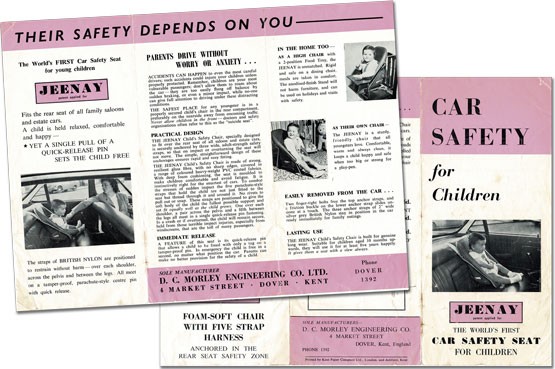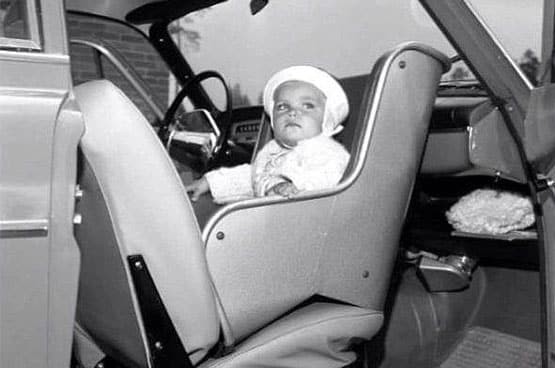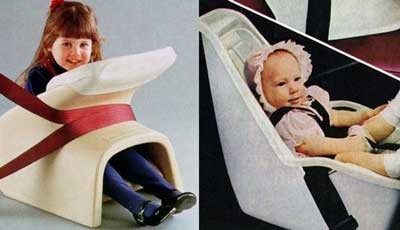When Were Car Seats Invented? The development of child safety seats represents a significant advancement in automotive safety, and CARS.EDU.VN is here to help you understand its full history. This guide explores the evolution of child restraints, highlights key innovations, and underscores the importance of proper car seat usage with resources on safety guidelines and selection advice for concerned parents. Explore the evolution of automotive safety and child passenger protection.
1. Early Innovations in Child Car Seats
Initially, car seats were primarily designed for convenience rather than safety. These early models aimed to elevate children, allowing them a better view from the car and keeping them somewhat contained.
1.1 The Burlap Sack Era: Early Child Restraints
In the earliest days of automobiles, “child seats” were rudimentary. Imagine a burlap sack with a drawstring, simply hung over the passenger seat’s headrest. These offered minimal safety, focusing more on keeping the child in one place.
1.2 Booster Seats Arrive: The Bunny Bear Company (1933)
The Bunny Bear Company introduced a seat in 1933 that functioned as a basic booster seat. It elevated children in the back seat, enabling parents to keep a closer watch on them.
1.3 Playful Distractions: The 1940s Canvas Seats
During the 1940s, manufacturers created canvas seats with metal frames that attached to the car’s front seat. These seats often included a toy steering wheel to entertain the child, keeping them occupied during rides.
2. The Dawn of Safety-Conscious Car Seats
It took roughly three decades before the concept of car seats as safety devices began to take hold. The late 1950s and early 1960s marked a crucial turning point.
2.1 1959: The Introduction of the 3-Point Seat Belt
The advent of the 3-point seat belt (lap-shoulder belt) in 1959 was a pivotal moment. This innovation significantly improved occupant safety, setting the stage for more advanced child restraint systems. By 1959, the motor-vehicle death rate was four to five times higher than in recent years. The rate began to drop in the early 1970s after the introduction of safety-equipment regulations and laws.
2.2 1962: Pioneers of Safety-Focused Car Seats
In 1962, two inventors independently began designing car seats with safety as a primary concern: Jean Helen Ames and Leonard Rivkin.
- Jean Helen Ames: A British mother and journalist, Ames is credited with being among the first to propose safety seats for children. She designed a rear-facing seat with a Y-belt to restrain the child. In 1965, she filed patents for a 5-strap safety harness made of “British Nylon to restrain without harm” and a “tamper-proof, parachute-style centre pin with quick release” buckle.
- Leonard Rivkin: A Denver businessman and retired civil engineer, Rivkin created a seat with an iron-framed booster and a revolutionary five-point harness system. His motivation stemmed from an incident where his son was thrown from the back seat during a car accident.
2.3 1964: The Rear-Facing Revolution
In 1964, Swedish professor Bertil Aldman recognized the safety benefits of rear-facing car seats after observing the astronauts’ position in the Gemini space capsule on an American TV program. He designed the first rear-facing car seat, leading Sweden to adopt stringent “T-standard” regulations that favored rear-facing designs.
2.4 1968: Automakers Enter the Fray
By 1968, major auto manufacturers like Ford and General Motors began developing car seats with crash protection in mind. Ford introduced the Tot-Guard, while General Motors created the Love Seat for Toddlers and the Infant Love Seat, the first rear-facing only restraint.
3. Regulatory Milestones in Car Seat History
The introduction of car seat regulations marked a critical step in ensuring child passenger safety. It took nearly a decade from the innovation of safety car seats to the beginning of regulations.
3.1 1971: The First Federal Standards
In 1971, the National Highway Traffic Safety Administration (NHTSA) adopted the first federal standards for car seats, FMVSS213. These initial standards focused on requiring safety belts to secure the car seat to the vehicle and harnesses to restrain the child but did not include crash tests.
3.2 1979: Tennessee’s Pioneering Child Restraint Law
Tennessee became the first state to enact a child restraint law in 1979, mandating the use of car seats for children.
3.3 1985: Universal Car Seat Laws
By 1985, all states in the United States had laws requiring the use of car seats. However, even by 1987, only 80% of children were using them, indicating that legislation alone was not enough to ensure universal adoption.
4. Modern Car Seat Technology and Regulations
Today, car seat technology continues to evolve, driven by ongoing research, stricter regulations, and a growing awareness of child passenger safety.
4.1 LATCH Systems: Enhancing Installation and Stability
LATCH (Lower Anchors and Tethers for Children) systems were introduced to simplify car seat installation and improve stability. By 2003, federal regulations required all car manufacturers to include complete LATCH systems in their vehicles.
4.2 Strict Federal Crash Test Regulations
Car seats must meet stringent federal crash test regulations that are continually updated to enhance safety standards. These tests simulate real-world accident scenarios to ensure that car seats provide adequate protection.
4.3 Expiration Dates and Safety Recalls
Child restraints now come with expiration dates, as materials can degrade over time, affecting their safety performance. Parents are also more attentive to safety recalls, promptly addressing any potential issues with their car seats.
4.4 Child Passenger Safety Technicians: Ensuring Proper Installation
Parents today often conduct thorough research on car seat options and seek assistance from certified Child Passenger Safety Technicians to ensure correct installation.
5. Current Challenges and Future Directions
Despite significant advancements, challenges remain in achieving 100% car seat usage and ensuring correct installation.
5.1 Usage Rates and Misuse Statistics
Even with widespread awareness and legal mandates, car seat usage is not universal. Statistics reveal that many child fatalities in car crashes occur because the child was unrestrained. Furthermore, a significant percentage of car seats are used incorrectly, reducing their effectiveness.
5.2 The Future of Car Seat Technology
Ongoing innovations in car seat technology aim to improve safety and convenience. Products like the RideSafer Travel Vest and the Tummy Shield are being developed to offer enhanced protection for children of all ages, including unborn babies.
5.3 CARS.EDU.VN: Your Partner in Automotive Safety
At CARS.EDU.VN, we are dedicated to providing comprehensive information and resources to help you make informed decisions about automotive safety. Whether you are looking for detailed service information, maintenance tips, or expert car reviews, CARS.EDU.VN is your trusted source.
6. Detailed Timeline of Car Seat Inventions and Regulations
To provide a clearer picture of the evolution of car seats, here’s a detailed timeline:
| Year | Event |
|---|---|
| Early Automobiles | Rudimentary child seats, mainly burlap sacks. |
| 1933 | Bunny Bear Company introduces booster seats. |
| 1940s | Canvas seats with metal frames and toy steering wheels. |
| 1959 | 3-point seat belt introduced. |
| 1962 | Jean Helen Ames and Leonard Rivkin design safety-focused car seats. |
| 1964 | Bertil Aldman designs the first rear-facing car seat. |
| 1968 | Ford Tot-Guard and GM Love Seat introduced. |
| 1971 | NHTSA adopts first federal car seat standards (FMVSS213). |
| 1979 | Tennessee enacts the first child restraint law. |
| 1985 | All states have car seat laws. |
| 2003 | LATCH systems required in all new cars. |




7. The Ongoing Debate: Are Car Seats Truly Necessary?
Despite overwhelming evidence supporting the effectiveness of car seats, some individuals question their necessity. This skepticism often stems from personal experiences or a lack of understanding of the physics involved in car crashes.
7.1 Addressing Common Misconceptions
One common misconception is that holding a child in your arms is sufficient protection during a crash. However, the force of a collision can make it impossible to hold onto a child, potentially resulting in severe injuries or fatalities.
7.2 The Science Behind Car Seat Safety
Car seats are designed to distribute crash forces across the strongest parts of a child’s body, minimizing the risk of injury. Rear-facing car seats, in particular, provide superior protection for infants and young children by supporting the head, neck, and spine.
7.3 Expert Opinions and Recommendations
Safety experts and organizations like the American Academy of Pediatrics (AAP) strongly recommend the use of car seats for all children until they reach the appropriate height and weight for adult seat belts.
8. Maximizing Car Seat Safety: Practical Tips
To ensure your child’s safety in the car, follow these practical tips:
- Choose the Right Seat: Select a car seat that is appropriate for your child’s age, weight, and height.
- Read the Instructions: Carefully read and follow the manufacturer’s instructions for installing and using the car seat.
- Proper Installation: Ensure the car seat is correctly installed, either using the LATCH system or the vehicle’s seat belt.
- Harness Fit: Make sure the harness straps fit snugly and are positioned correctly on your child’s shoulders.
- Rear-Facing as Long as Possible: Keep your child in a rear-facing car seat until they reach the maximum height or weight limit recommended by the manufacturer.
- Avoid Bulky Clothing: Dress your child in thin layers to ensure the harness straps fit properly.
- Never Leave a Child Unattended: Never leave a child unattended in a car, even for a short period.
9. How CARS.EDU.VN Supports Your Automotive Needs
CARS.EDU.VN offers a wealth of resources to assist you with all your automotive needs. Our services include:
- Detailed Car Reviews: Comprehensive reviews of the latest car models, helping you make informed purchasing decisions.
- Maintenance Guides: Step-by-step guides to help you keep your car in top condition.
- Service Information: Access to trusted service providers and repair shops.
- Safety Tips: Expert advice on how to stay safe on the road, including car seat recommendations.
By leveraging the expertise and resources available at CARS.EDU.VN, you can ensure that you are making the best choices for your family’s safety and well-being.
10. Understanding Car Seat Laws Across the United States
Car seat laws vary by state, so it’s important to be aware of the specific requirements in your area. Here’s a general overview:
| State | Rear-Facing Requirements | Forward-Facing Requirements | Booster Seat Requirements |
|---|---|---|---|
| California | Until 2 years old unless child weighs 40 lbs or is 40 inches tall | Over 2 years and 40 lbs; Under 8 years or 4’9″ | Until 8 years old or 4’9″ |
| New York | Until 2 years old | Over 2 years; Until 4 years old | Until 8 years old |
| Texas | Until child meets weight and height limits | After outgrowing rear-facing seat | Until 8 years old or 4’9″ |
| Florida | Until child is 3 years old | After outgrowing rear-facing seat; 4-5 years old | Until 6 years old |
These are general guidelines, and it’s crucial to check your state’s specific laws for detailed information.
11. Choosing the Right Car Seat: A Comprehensive Guide
Selecting the appropriate car seat for your child involves considering various factors, including age, weight, height, and developmental stage. Here’s a breakdown of the different types of car seats:
11.1 Rear-Facing Car Seats
- Infant Car Seats: Designed for newborns and infants, these seats are typically used from birth until the child reaches the maximum weight or height limit.
- Convertible Car Seats: These seats can be used rear-facing and later converted to forward-facing as the child grows.
11.2 Forward-Facing Car Seats
- Convertible Car Seats: As mentioned above, these seats can be switched to forward-facing mode.
- Combination Car Seats: These seats combine a forward-facing harness with a booster seat.
11.3 Booster Seats
- High-Back Booster Seats: These seats provide back and head support.
- Backless Booster Seats: These seats simply elevate the child to ensure proper seat belt fit.
When choosing a car seat, consider the following:
- Safety Ratings: Check safety ratings from organizations like NHTSA and the Insurance Institute for Highway Safety (IIHS).
- Ease of Use: Look for car seats that are easy to install and adjust.
- Comfort: Choose a car seat with adequate padding and comfortable fabric.
- Lifespan: Consider the lifespan of the car seat, as some models can accommodate children through multiple stages.
12. Debunking Common Car Seat Myths
Several myths and misconceptions surround car seat usage. Let’s debunk some of the most common ones:
- Myth: “My child hates the car seat, so it’s okay to let them out sometimes.”
- Fact: Car seats are essential for safety, regardless of a child’s preferences.
- Myth: “It’s okay to use a used car seat from a friend or family member.”
- Fact: Used car seats may have hidden damage or be subject to recalls. Only use a used car seat if you know its history and it meets current safety standards.
- Myth: “My child is big enough for an adult seat belt.”
- Fact: Children should use booster seats until they reach the appropriate height and weight for adult seat belts to fit properly.
- Myth: “All car seats are equally safe.”
- Fact: Car seats vary in safety performance. Check safety ratings and reviews to choose the best option.
13. Expert Insights: Interviews with Child Passenger Safety Technicians
To gain further insights into car seat safety, we spoke with several certified Child Passenger Safety Technicians. Here are some key takeaways:
- Importance of Proper Installation: “The most common mistake I see is incorrect installation. A car seat that isn’t properly installed won’t protect a child in a crash.”
- Rear-Facing Benefits: “Keeping children rear-facing as long as possible is crucial. It provides the best protection for their head, neck, and spine.”
- Harness Fit: “Make sure the harness straps are snug and positioned correctly. You shouldn’t be able to pinch any slack in the straps.”
- Regular Inspections: “I recommend having your car seat checked by a certified technician regularly to ensure it’s installed correctly and appropriate for your child’s size.”
14. The Role of Technology in Modern Car Seats
Advancements in technology have significantly enhanced the safety and convenience of modern car seats. Some notable innovations include:
- Sensors and Alerts: Some car seats now feature sensors that detect if a child is left unattended in the car and send alerts to the parent’s phone.
- Smart Harness Systems: These systems use sensors to ensure the harness straps are properly tightened and positioned.
- Energy-Absorbing Materials: Car seats are now made with advanced materials that absorb and distribute crash forces, reducing the risk of injury.
- 360-Degree Rotating Car Seats: These car seats rotate to make it easier to get a child in and out of the car.
15. Resources for Parents: Where to Find Help and Information
Numerous resources are available to help parents stay informed about car seat safety:
- National Highway Traffic Safety Administration (NHTSA): Provides safety ratings, recall information, and educational materials.
- American Academy of Pediatrics (AAP): Offers guidelines and recommendations on child passenger safety.
- Safe Kids Worldwide: Provides resources and programs to prevent childhood injuries.
- Certified Child Passenger Safety Technicians: Can inspect car seat installations and provide personalized guidance.
- CARS.EDU.VN: Your go-to source for comprehensive automotive information, including safety tips and car seat recommendations.
16. The Psychological Impact of Car Accidents on Children
Beyond the physical injuries, car accidents can have a significant psychological impact on children. It’s important to address their emotional needs after a crash.
16.1 Common Emotional Reactions
Children may experience a range of emotional reactions after a car accident, including:
- Fear and Anxiety: They may become fearful of riding in cars or experience anxiety related to traffic.
- Nightmares: They may have nightmares or disturbed sleep patterns.
- Regression: Younger children may regress to earlier behaviors, such as bedwetting or thumb-sucking.
- Irritability: They may become more irritable or have difficulty concentrating.
16.2 How to Support Your Child
Here are some ways to support your child after a car accident:
- Reassure Them: Reassure them that they are safe and that you will protect them.
- Listen to Their Concerns: Listen to their concerns and validate their feelings.
- Seek Professional Help: If your child is experiencing significant emotional distress, seek professional help from a therapist or counselor.
- Maintain Routine: Maintain a normal routine to provide a sense of stability and security.
- Be Patient: Be patient and understanding, as it may take time for your child to recover emotionally.
17. The Impact of Autonomous Vehicles on Child Passenger Safety
The emergence of autonomous vehicles presents both opportunities and challenges for child passenger safety.
17.1 Potential Benefits
Autonomous vehicles have the potential to reduce accidents caused by human error, leading to safer outcomes for child passengers.
17.2 New Considerations
However, autonomous vehicles also raise new questions about car seat design and usage:
- Seating Configurations: How will car seats be designed for vehicles with flexible seating configurations?
- Supervision: How will parents supervise children in autonomous vehicles?
- Emergency Situations: How will children be protected in emergency situations where human intervention is required?
These are complex issues that require careful consideration and collaboration between automakers, safety experts, and regulators.
18. Navigating Car Seat Recalls: What You Need to Know
Car seat recalls are issued when a safety defect is discovered. It’s important to stay informed about recalls and take prompt action if your car seat is affected.
18.1 How to Stay Informed
- Register Your Car Seat: Register your car seat with the manufacturer to receive recall notifications.
- Check NHTSA’s Website: Regularly check NHTSA’s website for recall information.
- Follow Manufacturer’s Instructions: If your car seat is recalled, follow the manufacturer’s instructions for obtaining a replacement or repair.
18.2 Taking Action
- Stop Using the Car Seat: If your car seat is recalled, stop using it immediately.
- Contact the Manufacturer: Contact the manufacturer for instructions on how to proceed.
- Follow the Remedy: Follow the manufacturer’s instructions for obtaining a replacement or repair.
19. Advanced Car Seat Features: Enhancing Safety and Comfort
Modern car seats offer a range of advanced features designed to enhance safety and comfort:
- Side-Impact Protection: Provides additional protection in side-impact crashes.
- Adjustable Headrests: Accommodates a child’s growing height.
- Recline Features: Allows for comfortable positioning for sleeping children.
- Breathable Fabrics: Keeps children cool and comfortable.
- Easy-to-Clean Materials: Makes it easier to keep the car seat clean.
When choosing a car seat, consider which features are most important to you and your child.
20. Conclusion: Prioritizing Child Passenger Safety
The history of car seats is a testament to ongoing efforts to protect children in vehicles. From rudimentary burlap sacks to advanced, technology-driven restraints, car seats have evolved significantly over the years. By staying informed, following safety guidelines, and utilizing resources like CARS.EDU.VN, you can prioritize child passenger safety and ensure that your children are protected on every journey.
Visit CARS.EDU.VN today to explore our comprehensive resources on car safety, maintenance, and reviews. Contact us at 456 Auto Drive, Anytown, CA 90210, United States, or call us on Whatsapp: +1 555-123-4567. Let CARS.EDU.VN be your trusted partner in automotive safety.
FAQ: Car Seat Safety
- When was the first car seat invented?
The earliest forms of car seats, primarily designed for convenience, appeared in the early 1930s. - Who invented the first safety-focused car seat?
Jean Helen Ames and Leonard Rivkin independently designed car seats with safety in mind around 1962. - Why is it important to use a car seat?
Car seats distribute crash forces and protect children from serious injuries or fatalities in the event of a car accident. - What is the LATCH system?
LATCH (Lower Anchors and Tethers for Children) is a system that simplifies car seat installation and enhances stability. - How long should a child use a rear-facing car seat?
Children should remain in rear-facing car seats until they reach the maximum height or weight limit recommended by the manufacturer, ideally until at least age two. - What are the most common car seat mistakes?
Common mistakes include incorrect installation, loose harness straps, and transitioning to a forward-facing seat too soon. - Where can I get my car seat checked for proper installation?
Certified Child Passenger Safety Technicians can inspect car seat installations and provide personalized guidance. - How do I know if my car seat has been recalled?
Register your car seat with the manufacturer and regularly check NHTSA’s website for recall information. - What should I do after a car accident involving my child?
Ensure your child receives medical attention, address their emotional needs, and have the car seat inspected for damage. - Where can I find more information about car seat safety?
Visit cars.edu.vn for comprehensive resources, safety tips, and car seat recommendations.